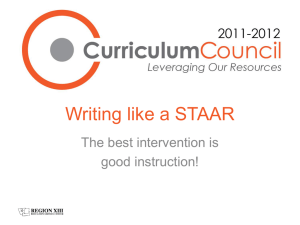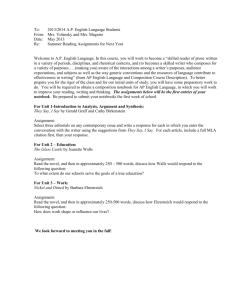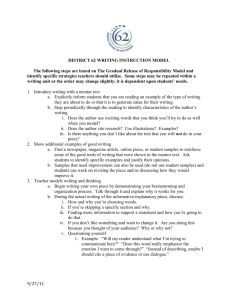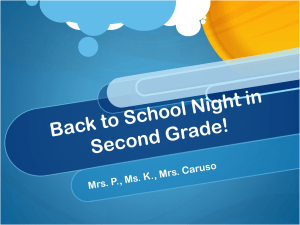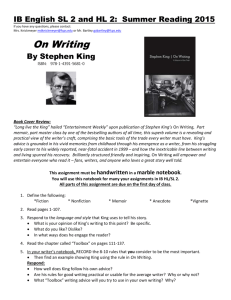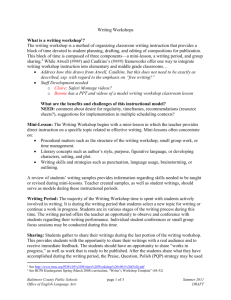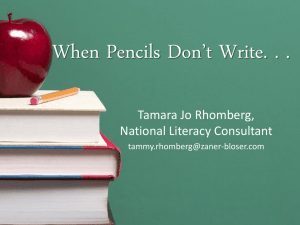Managing the 60-minute Mathematics Instructional Block
advertisement
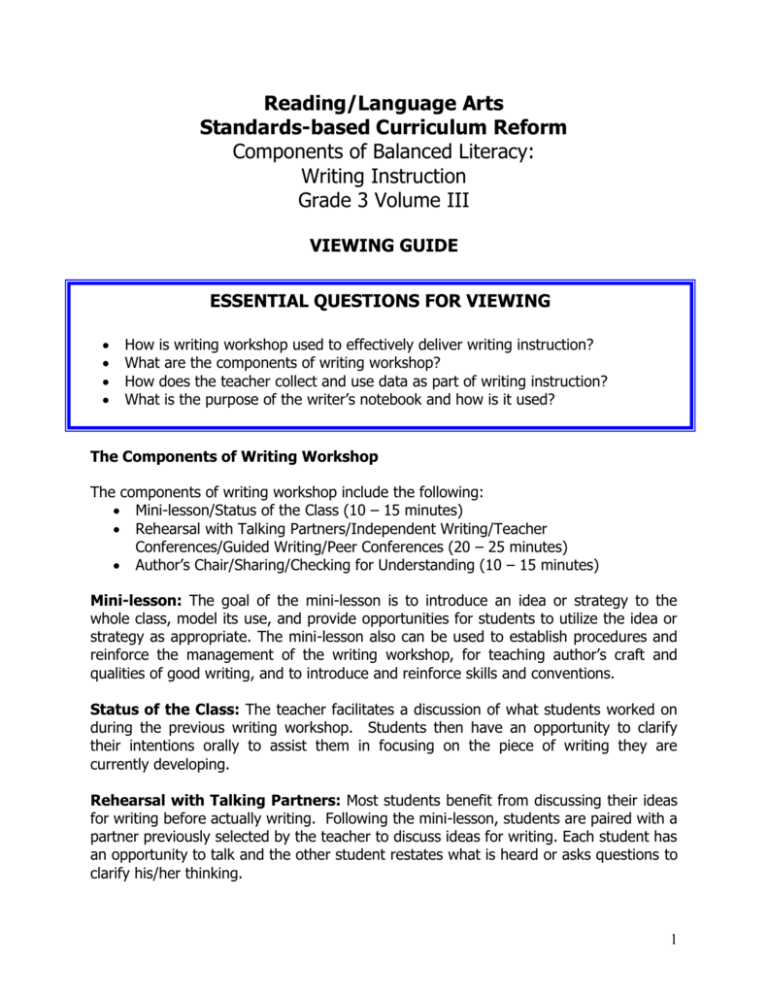
Reading/Language Arts Standards-based Curriculum Reform Components of Balanced Literacy: Writing Instruction Grade 3 Volume III VIEWING GUIDE ESSENTIAL QUESTIONS FOR VIEWING How is writing workshop used to effectively deliver writing instruction? What are the components of writing workshop? How does the teacher collect and use data as part of writing instruction? What is the purpose of the writer’s notebook and how is it used? The Components of Writing Workshop The components of writing workshop include the following: Mini-lesson/Status of the Class (10 – 15 minutes) Rehearsal with Talking Partners/Independent Writing/Teacher Conferences/Guided Writing/Peer Conferences (20 – 25 minutes) Author’s Chair/Sharing/Checking for Understanding (10 – 15 minutes) Mini-lesson: The goal of the mini-lesson is to introduce an idea or strategy to the whole class, model its use, and provide opportunities for students to utilize the idea or strategy as appropriate. The mini-lesson also can be used to establish procedures and reinforce the management of the writing workshop, for teaching author’s craft and qualities of good writing, and to introduce and reinforce skills and conventions. Status of the Class: The teacher facilitates a discussion of what students worked on during the previous writing workshop. Students then have an opportunity to clarify their intentions orally to assist them in focusing on the piece of writing they are currently developing. Rehearsal with Talking Partners: Most students benefit from discussing their ideas for writing before actually writing. Following the mini-lesson, students are paired with a partner previously selected by the teacher to discuss ideas for writing. Each student has an opportunity to talk and the other student restates what is heard or asks questions to clarify his/her thinking. 1 Independent Writing: After choosing their own topics, students practice newly developing skills during independent writing. While students are engaged in independent writing, the teacher conducts visiting and/or individual conferences and guided writing groups. Students may peer conference. Closer Look Choice is an essential element of effective writing instruction. The writing workshop allows students to explore various genres and techniques while writing about topics of interest to them. Visiting Conferences: The teacher roams among students to encourage on-task behavior, provides students with encouragement and praise, and asks questions that motivate students to continue writing. Examples of effective visiting conference questions are: What is you piece about? What do you like most about your piece? What will you work on next in this piece? Tell me about this character. What does he/she like to do? How did you feel when this happened? Did you write you feelings? What kinds of changes did you make from your last draft? What do you need help on? Closer Look Following visiting conferences the teacher might see several students with similar needs, such as difficulty getting started, spelling, or grammar needs. Those students can be called together for a quick mini-lesson. This group work is not planned and is called Impromptu Group Work. Guided Writing Groups: The teacher meets with a small group to address needs determined by analyzing previous writing products. Students could bring their writing from the previous day to make changes during the group time. Individual Conferences: The teacher and student confer for revision and editing purposes to prepare pieces for publishing. 2 Closer Look Students need to observe their teacher modeling revision strategies. They must understand that all authors improve their writing through revision. Remember, not every piece of writing is taken to publication. Students need time to practice the craft of writing. Peer Conferences: Peer conferences allow students to give each other feedback about their writing in order to improve their writing pieces. Author’s Chair/Sharing: Author’s Chair is a time for students to share their writing with classmates. Sharing may include published or draft pieces. Although students should have a choice in what they share, the teacher provides opportunities for students to share writing in which they applied the strategies presented during the mini-lesson. Checking for Understanding: Following the Author’s Chair, the teacher checks for understanding by revisiting the essential question and purpose for the mini-lesson. MINI-LESSON The teacher begins the mini-lesson with the essential question and explicitly states the purpose of the lesson. The teacher shares the first entry, a special memory, in her writer’s notebook. First she talks about the memory to convey to the students that writing does not have to include every detail of the memory. She also shares a memory from a third grade student to provide another perspective. Reflection: What did you notice about the organization and pacing of the mini-lesson? The teacher begins by stating the essential question. The mini-lesson is short, succinct, and purposeful. The teacher introduced the notebook entry, a special memory, by sharing her memory and one from a third grade student. Reflection: What is the purpose of the writer’s notebook? One of the most significant changes from second to third grade writing is the use of a writer’s notebook. 3 The writer’s notebook is a blank book that serves as a rehearsal for writing. Rough drafts develop from the writer’s notebook. It’s a tool that many professional writers use to capture their thoughts, memories, observations, wonderings, and feelings. The writer’s notebook is not corrected for spelling, grammar, etc., but is a “safe haven” for student writing. Writer’s notebooks serve as formative assessment that provides ideas for minlessons. Closer Look Using student writing is a powerful motivator. It communicates to students that “these entries were written by students just like you. You can do this, too.” Begin to copy student writing, including notebook entries, that you can use in the future. REHEARSAL WITH TALKING PARTNERS In preparation for writing, the students discuss their special memories with a partner. Reflection: What are the benefits of rehearsal with talking partners? Provides students with an opportunity to try out ideas. Can motivate reluctant writers. Can clarify a student’s thoughts through questioning. INDEPENDENT WRITING Following the mini-lesson and rehearsal with talking partners, the students have the opportunity to write about their special memories in their writers’ notebooks. Reflection: How does the teacher use the independent writing time to support student writing? 4 The students are encouraged to write about a memory that is important to them. This allows the students the element of choice, which is essential for effective instruction. Through visiting conferences, the teacher roams around the room asking focused questions to motivate student writing. When the teacher notices that one student is having difficulty getting started, she directs the student to talk with a student who is busily engaged. This interaction sparks an idea and the student returns to her seat and begins writing. This conferring, side-by-side with the student, places the teacher in the role of coach, supporter, and writer. The teacher takes notes on the strengths and needs of the students, which is helpful in planning for future and longer conferences. Closer Look Later in the quarter, as the teacher understands the writing strengths and needs of the students, he/she may form guided writing groups to focus on specific skills and strategies. In addition, the teacher will begin holding individual conferences for revision and editing purposes to prepare for publishing. SHARING/AUTHOR’S CHAIR Two students share what they wrote in their writers’ notebooks. The teacher also models how the Author’s Chair is used to clarify whether or not the writing conveys the author’s intent. The other students share with partners and provide reciprocal feedback. Reflection: Why is it important for students to share their writing and ask, “What did you hear about my memory?” Knowing that they will share at the end of the writing workshop period will motivate students to use their time wisely. It validates the student’s attempt as an author. Students know that they will have an audience for what was written that day. 5 Asking, “What did you hear about my memory” lets the author know if he/she communicated the message as he/she intended. Checking for Understanding The teacher checks for understanding by asking, “Who can tell me what they learned about writing about a memory?” Reflection: Why is it important for the teacher to check for understanding? It is formative assessment for the teacher and helps in determining future topics for the mini-lesson. When a student reflects on his/her writing, it provides a window for the teacher to view the student’s thinking. Debriefing The debriefing is a discussion of the lessons featured on the video with the teacher, a balanced literacy specialist, and a staff development specialist. It is divided into sections and focuses on the essential questions posed at the beginning of the video. How is writing workshop used to effectively deliver writing instruction? What are the components of writing workshop? How does the teacher collect and use data as part of writing instruction? What is the purpose of the writer’s notebook and how is it used? Section I: Writing Instruction in Writing Workshop Section II: Publishing Section III: Using Assessment to Plan Instruction Section IV: The Writer’s Notebook Section V: Classroom Management 08/13/03 6
